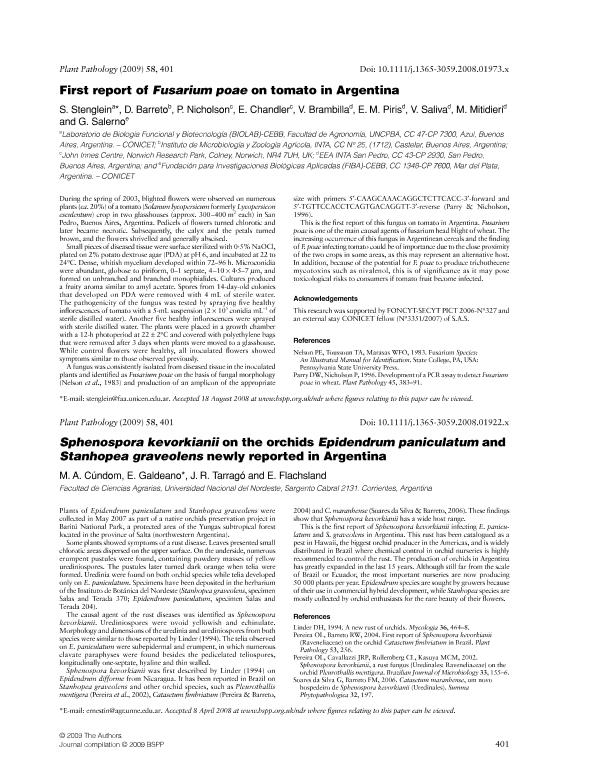Artículo
First report of Fusarium poae on tomato in Argentina
Stenglein, Sebastian Alberto ; Barreto, D.; Nicholson, P.; Chandler, E.; Brambilla, V.; Piris, E. M.; Saliva, V.; Mitidieri, Mariel Silvina; Salerno, Graciela Lidia
; Barreto, D.; Nicholson, P.; Chandler, E.; Brambilla, V.; Piris, E. M.; Saliva, V.; Mitidieri, Mariel Silvina; Salerno, Graciela Lidia
 ; Barreto, D.; Nicholson, P.; Chandler, E.; Brambilla, V.; Piris, E. M.; Saliva, V.; Mitidieri, Mariel Silvina; Salerno, Graciela Lidia
; Barreto, D.; Nicholson, P.; Chandler, E.; Brambilla, V.; Piris, E. M.; Saliva, V.; Mitidieri, Mariel Silvina; Salerno, Graciela Lidia
Fecha de publicación:
12/2009
Editorial:
Wiley Blackwell Publishing, Inc
Revista:
Plant Pathology
ISSN:
0032-0862
Idioma:
Inglés
Tipo de recurso:
Artículo publicado
Clasificación temática:
Resumen
During the spring of 2003, blighted flowers were observed on numerous plants (ca. 20%) of a tomato (Solanum lycopersicum formerly Lycopersicon esculentum) crop in two glasshouses (approx. 300–400 m2 each) in San Pedro, Buenos Aires, Argentina. Pedicels of flowers turned chlorotic and later became necrotic. Subsequently, the calyx and the petals turned brown, and the flowers shrivelled and generally abscised. Small pieces of diseased tissue were surface sterilized with 0·5% NaOCl, plated on 2% potato dextrose agar (PDA) at pH 6, and incubated at 22 to 24°C. Dense, whitish mycelium developed within 72–96 h. Microconidia were abundant, globose to piriform, 0–1 septate, 4–10 × 4·5–7 µm, and formed on unbranched and branched monophialides. Cultures produced a fruity aroma similar to amyl acetate. Spores from 14‐day‐old colonies that developed on PDA were removed with 4 mL of sterile water. The pathogenicity of the fungus was tested by spraying five healthy inflorescences of tomato with a 5‐mL suspension (2 × 105 conidia mL−1 of sterile distilled water). Another five healthy inflorescences were sprayed with sterile distilled water. The plants were placed in a growth chamber with a 12‐h photoperiod at 22 ± 2°C and covered with polyethylene bags that were removed after 3 days when plants were moved to a glasshouse. While control flowers were healthy, all inoculated flowers showed symptoms similar to those observed previously. A fungus was consistently isolated from diseased tissue in the inoculated plants and identified as Fusarium poae on the basis of fungal morphology (Nelson et al., 1983) and production of an amplicon of the appropriate size with primers 5′‐CAAGCAAACAGGCTCTTCACC‐3′‐forward and 5′‐TGTTCCACCTCAGTGACAGGTT‐3′‐reverse (Parry & Nicholson, 1996). This is the first report of this fungus on tomato in Argentina. Fusarium poae is one of the main causal agents of fusarium head blight of wheat. The increasing occurrence of this fungus in Argentinean cereals and the finding of F. poae infecting tomato could be of importance due to the close proximity of the two crops in some areas, as this may represent an alternative host. In addition, because of the potential for F. poae to produce trichothecene mycotoxins such as nivalenol, this is of significance as it may pose toxicological risks to consumers if tomato fruit become infected.
Palabras clave:
FUSARIUM POAE
,
TOMATO
Archivos asociados
Licencia
Identificadores
Colecciones
Articulos(INBIOTEC)
Articulos de INSTITUTO DE INV. EN BIODIVERSIDAD Y BIOTECNOLOGIA
Articulos de INSTITUTO DE INV. EN BIODIVERSIDAD Y BIOTECNOLOGIA
Articulos(OCA PQUE. CENTENARIO)
Articulos de OFICINA DE COORDINACION ADMINISTRATIVA PQUE. CENTENARIO
Articulos de OFICINA DE COORDINACION ADMINISTRATIVA PQUE. CENTENARIO
Citación
Stenglein, Sebastian Alberto; Barreto, D.; Nicholson, P.; Chandler, E.; Brambilla, V.; et al.; First report of Fusarium poae on tomato in Argentina; Wiley Blackwell Publishing, Inc; Plant Pathology; 58; 2; 12-2009; 401-401
Compartir
Altmétricas



